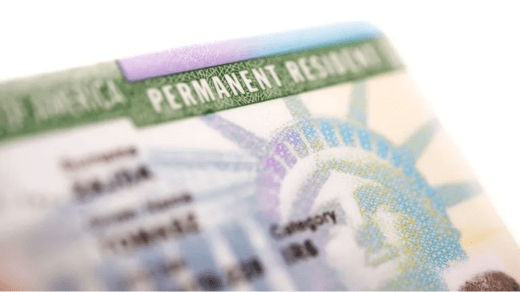Adjustment of Status (AOS) is a process in the United States that allows certain foreign nationals who are already in the country to apply for lawful permanent resident status, commonly known as a green card, without having to leave the United States. This process is typically available to individuals who are eligible for family-sponsored or employment-based immigrant visas, as well as certain other categories of immigrants.
The key features of the Adjustment of Status process include:
- Eligibility: To be eligible for AOS, you must meet specific criteria, such as having an approved immigrant petition, maintaining legal status, and meeting any other requirements associated with your visa category.
- Form I-485: The primary application for Adjustment of Status is the Form I-485, Application to Register Permanent Residence or Adjust Status. This form is filed with U.S. Citizenship and Immigration Services (USCIS) and is used to request permanent resident status.
- Biometrics and Background Checks: After submitting the I-485 application, applicants typically undergo biometric fingerprinting and background checks for security and criminal history.
- Interview: In many cases, applicants are required to attend an interview at a USCIS office, where they will be asked questions about their application and their eligibility for adjustment of status.
- Medical Examination: Applicants are required to undergo a medical examination by an authorized civil surgeon to demonstrate that they do not pose a public health risk.
- Supporting Documentation: You must provide various supporting documents with your application, including birth certificates, passport photos, financial records, and other evidence of your eligibility.
- Affidavit of Support: In many cases, a U.S. sponsor must submit an Affidavit of Support (Form I-864) to demonstrate that the applicant will not become a public charge.
- Visa Bulletin: The availability of immigrant visa numbers can affect the timing of the Adjustment of Status process, particularly in family-sponsored and employment-based categories. The Visa Bulletin issued by the U.S. Department of State indicates when visa numbers are available.
- Work Authorization and Travel Document: While your Adjustment of Status application is pending, you may be eligible for a work permit (Employment Authorization Document) and a travel document (Advance Parole) that allows you to work and travel while your application is being processed.
- Conditional Permanent Residence: In some cases, the green card issued as a result of the AOS process may be conditional, typically for two years. After this period, you may need to apply to have the conditions removed to obtain a regular, non-conditional green card.
It’s essential to note that the AOS process can be complex and the specific requirements and procedures can vary based on your visa category and individual circumstances. Consulting with an immigration attorney or seeking guidance from USCIS is often recommended to ensure that you follow the correct procedures and meet all eligibility requirements.
How to apply for Adjustment of Status?
Applying for Adjustment of Status (AOS) in the United States is a multi-step process that involves several forms, supporting documentation, and specific requirements. Here are the general steps to apply for AOS:
- Determine Eligibility:
- Make sure you are eligible for AOS based on your visa category. Common categories include family-sponsored, employment-based, diversity visa, refugee/asylee status, and more.
- File an Immigrant Petition (if required):
- In many cases, you or your sponsor (if applicable) must file an immigrant petition on your behalf. This includes Form I-130 for family-sponsored immigrants or Form I-140 for employment-based immigrants. The petition must be approved before you can apply for AOS.
- Check Visa Bulletin:
- Consult the Visa Bulletin published by the U.S. Department of State to determine if a visa number is available in your category. Your priority date (the date USCIS received your immigrant petition) must be current for you to proceed with AOS.
- Gather Supporting Documents:
- Collect the necessary documentation, which may include birth certificates, passport photos, marriage certificates (if applicable), financial records, and any other evidence required for your specific case.
- Complete Form I-485:
- Fill out Form I-485, Application to Register Permanent Residence or Adjust Status, available on the USCIS website. Ensure that you complete all sections accurately and honestly.
- Pay Filing Fees:
- Submit the required filing fees for Form I-485, along with any additional fees for services like biometrics (fingerprinting).
- Submit the Application Package:
- Mail your completed Form I-485, along with the supporting documents, fees, and any required additional forms, to the appropriate USCIS address. USCIS regularly updates its mailing addresses, so be sure to check the USCIS website for the latest information.
- Biometrics Appointment:
- After USCIS receives your application, you will be scheduled for a biometrics appointment to provide fingerprints, photographs, and a signature.
- Attend an Interview:
- In most cases, you will be required to attend an interview at a USCIS office. Be prepared to answer questions about your application and provide any additional documentation requested by the officer.
- Medical Examination:
- You must undergo a medical examination by an authorized civil surgeon and submit the completed Form I-693, Report of Medical Examination and Vaccination Record, as part of your application.
- Affidavit of Support:
- If applicable, your U.S. sponsor will need to submit an Affidavit of Support (Form I-864) to demonstrate their ability to financially support you.
- Work Authorization and Travel Document (Optional):
- While your AOS application is pending, you can apply for an Employment Authorization Document (EAD) and Advance Parole (travel document) using Form I-765 and Form I-131, respectively.
- Wait for USCIS Decision:
- USCIS will review your application, conduct background checks, and make a decision on your AOS application. This process can take several months.
- Receive Your Green Card:
- If your AOS application is approved, you will receive your green card by mail. In some cases, you may initially receive a conditional green card, which can later be converted to a regular, non-conditional green card.

